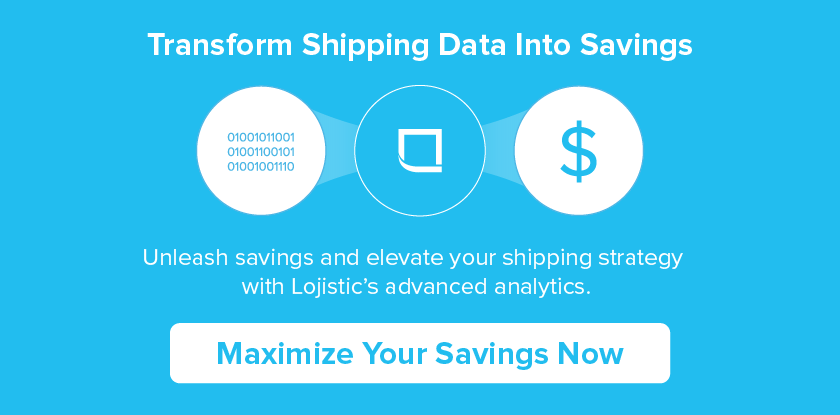If you think your hefty freight costs are doomed to stay sky-high forever, you’re in for a pleasant surprise.
Freight costs account for up to 10% of total logistics costs. Many businesses assume their freight expenses are pretty much set in stone. However, a few easy adjustments could cut these costs by as much as 50%.
But how can you achieve these savings without compromising on service? This quick article will fill you in on 7 surprisingly simple strategies on how to reduce freight costs—which can protect your business from creeping fees in 2024 while improving your customer experience.
Introduction: The Critical Role of Freight Cost Optimization
Why is freight cost optimization critical? Logistics costs are spiraling, and they’re threatening your bottom line. Case in point, the 2023 State of Logistics Report said that costs hit an all-time high, rising 19.8% year-on-year.
What’s behind the spike? Two main culprits:
- The international conflict has led to inflation through energy crises and export limits
- COVID-19 has caused supply chain problems, raising labor costs
They’ve created a ripple through supply chain costs you’re probably seeing reflected in your financial reports. Instead of leaving your logistics costs unchallenged, you can easily bring the clamp down by adopting some strategic technology and management. Here’s how to reduce freight costs:
Strategy 1: Harness Freight Audit and Payment Technologies
Tech is a powerful asset in the fight against freight shipping costs. In fact, at least 96% of 3PL providers have already migrated to the cloud.
The reason is that freight auditing and freight payment tech award a towering command over your logistics. Such perspective allows you to pinpoint and act on imperfections with greater ease.
Streamlining Cost Recovery and Payment Accuracy
You can use tech like freight auditing and payment software to scrutinize your shipping invoices and contracts. That way, you ensure you're only paying what you agreed to. It’ll also catch any discrepancies that could be inflating your costs. Plus:
- You’re fortified against payment errors – Technology is less prone than human error in payment mistakes. Should overcharges occur, you can trigger automatic recovery.
- You don’t need to compile data from disparate systems – Instead, your logistics and auditing data are compiled into one centralized platform for easy review.
- Your figures are all in the same place – So the tech can go to work benchmarking metrics and creating detailed shipping reports. These digital documents outline key areas for improvement using real-time geodata from different countries and zip codes.
The more volume you’re doing, the more important it is to have a streamlined operation for your freight shipping logistics.
Error-free operations also create better relationships with your freight carriers (which strengthens your position in negotiating freight rates).
Strategy 2: Optimize Carrier Selection Through Strategic Negotiations
Your carrier has a lot of power over your business. They impact your profit and your customers’ satisfaction. So, ensuring you’ve secured the best arrangement for your budget and needs is absolutely critical.
Some of the factors that will influence your decision might include:
- Frequency
- Budget
- Shipping volume
- Cargo type
- Destinations
- Transit time
- Special requirements
You can scope the market and strike a deal with the most suitable carrier. Your loyalty and volume will impact the leverage you bring to the table. Relationships compound; stature’s attractive. If you shop yourself as a long-term client with plenty of business, you can land a better deal than if you were to bounce between providers.
Monitor the carrier’s performance over time to ensure they’re holding up their end (and be prepared to reopen negotiations if necessary).
Leveraging Data for Better Rates and Terms
Data saves money. You can analyze the numbers and spot inefficiencies in all areas of your freight operation. A few ways to use shipping data to optimize your rates and terms include:
- Data-driven negotiations – Use historical data to negotiate better rates and terms with carriers.
- Market analysis for negotiation – Analyze industry benchmarks and competitors' rates to inform negotiation strategies.
- Route optimization insights – Present data-backed insights on optimized routes and transportation modes to negotiate cost-effective solutions.
- Demand forecasting for negotiation – Use data analytics to forecast future shipping volumes.
- Performance data for negotiation – Employ real-time performance data to negotiate contract terms that ensure carrier accountability.
Strategy 3: Implement Advanced Route and Mode Optimization
This strategy optimizes the movement of goods from their origin to their destination. It involves analyzing various factors such as transportation routes, modes of transportation (e.g., truck, rail, air, sea), scheduling, and logistics.
Proper route and mode optimization can:
- Reduce fuel consumption
- Decrease transit times
- Optimize resource use
- And ultimately boost cost savings—while improving supply chain performance
To make the right decisions, you can use advanced tech like:
- Route planning software
- Real-time tracking systems
- Predictive analytics
But, of course, the correct measures require a delicate balance.
Balancing Cost, Speed, and Reliability
The three core factors at play here involve:
- Cost efficiency – Select transport modes and routes that balance low cost with proper delivery. Opt for ocean freight over air for bulk shipments, for example, when timelines allow to enhance savings.
- Speed – Air freight is preferable for urgent deliveries, despite higher costs. Routing software can identify the quickest, cost-effective paths for different scenarios.
- Reliability – It might come at a premium, but carriers known for their dependability are more reliable in making timely, intact arrivals. However, reliability might outweigh the cost for critical shipments.
Once you have the broader strategy nailed down, you can begin to look at the specifics of what you’re shipping.
Strategy 4: Improve Operational Efficiency with Smart Packaging Solutions
Box up smarter and you’ll stack up savings. The goal is to minimize physical and volumetric weight. Great packaging strategies protect your products, but no more than necessary.
It’s as simple as evaluating your current packages and considering a redesign. Get the balance right, and you can enjoy lower freight charges with the same safe deliveries.
Reducing Dimensions and Weight for Lower Charges
Cost-effective shipping begins with scrutinizing the dimensions and weight of your packages.
Here’s how to go about it:
- Evaluate current packaging – Analyze your existing packaging methods to identify areas of waste and inefficiency. Is there excess material? Can you get rid of it without compromising protection?
- Adopt lighter materials – Shift toward lighter packaging options that maintain product safety without adding unnecessary weight.
- Optimize design – Design packaging to fit the product snugly. Cut material that contributes to increased dimensional weight.
- Leverage consolidation – Group smaller products into one package where feasible to reduce the overall number of packages shipped.
These basic changes could mean far lower shipping costs while maintaining—or even enhancing—customer satisfaction and product protection.
You’ll not only save money but also move toward sustainability. An efficient packaging process also has a positive downstream effect on every step in the supply chain.
Strategy 5: Enhance Load Consolidation Practices
In essence, effective load consolidation involves efficient use of space when loading shipments. When you combine several smaller shipments into one, you’ll need to ship less, so you’ll naturally save on costs.
You’ll also:
- Create less handling and reduce chances of damage – meaning smoother operations and higher customer satisfaction.
- Reduce fuel consumption and lower emissions – creating a supply chain that’s better for the planet.
There are a few useful ways to go about consolidating loads.
Maximizing Space and Minimizing Costs
Load consolidation involves combining multiple shipments destined for similar locations into one larger shipment. This approach is particularly beneficial for Less than Truckload (LTL) shipping, where individual shipments may not require the full capacity of a container or truck.
Because you only pay for the space your freight occupies, load consolidation can make transporting resources far cheaper.
Strategies for Effective Consolidation
To maximize the space you’re utilizing to save on cost, follow these steps:
- Volume assessment – Understand the frequency and volume of your LTL shipments to spot consolidation opportunities.
- Geographical planning – Use shipments that are geographically aligned to max out the efficiency of consolidated loads.
- Schedule coordination – Align the pickup and delivery times of various shipments for fluid consolidation.
- Carrier collaboration – Engage with carriers that are equipped and willing to handle consolidated shipments.
Strategy 6: Employ Sustainable Shipping Methods for Long-Term Savings
Transitioning to sustainable shipping practices isn’t just eco-friendly; you’ll also drive savings (not to mention building rapport with eco-conscious consumers). So how do you go about it?
Leveraging Green Practices for Cost-Efficiency
When done right, the value in environmentally friendly freight strategies is twofold: you’ll save on fees and protect your company’s commitment to sustainability.
Here are a few ways you can adopt green practices in shipping:
- Switch to renewable energy sources
- Streamline routes and consolidate shipments
- Explore alternative fuels like biodiesel or electric vehicles
- Minimize the use of packaging materials
- Use biodegradable packaging
- Reuse recycled packaging or other materials
- Favor ground transport over air
But if you want to kick your optimization into high gear for the long run, it pays to bring the right talent in-house.
Strategy 7: Develop a Knowledge-Driven Team
You can stay ahead of cost-saving opportunities if your employees are well-versed in the current trends, techniques, and data insights. When their discernment is attuned to cost-saving opportunities, they’ll naturally steer your operation toward continual improvement.
Cultivating Expertise for Informed Decision-Making
A well-informed team is the backbone of efficient and strategic operations. Here's how to cultivate expertise within your organization for better decision-making:
- Encourage ongoing education and professional development
- Create an environment that encourages sharing insights and best practices among team members and leadership
- Implement tools and systems that provide real-time data and analytics
- Create a culture where team members feel comfortable proposing new ideas and solutions
- Build a team with diverse skills and backgrounds
A strong team, the right tech, and these smart strategies. That’s how to reduce freight costs (and prepare your business for the future).
Integrating Strategies for Comprehensive Freight Cost Reduction
Act on the tips we’ve discussed and you can cut down your freight costs with astonishing speed and reliability. Not only that, you’ll likely find improvements in your shipping processes.
We’ve looked at tactical carrier negotiations, advanced routing, eco-conscious packaging, smart load consolidation, sustainable shipping adaptations, and nurturing an expert logistics team.
Lojistic’s powerful technology can kickstart your cost-savings journey. We help thousands of companies save truckloads of dollars on shipping every year. See how you can join them with our virtual demo or contact us to learn more.
Sources:
CSCMP. 34th Annual State of Logistics Report. cscmp.org/CSCMP/CSCMP/Educate/State_of_Logistics_Report.aspx
The Geography of Transport Systems. Transport Costs. https://transportgeography.org/contents/chapter3/transport-costs

Author
Rich Harkey
Rich Harkey
Senior Strategy Manager
As the Senior Strategy Manager at Lojistic, Rich leverages over three decades of expertise to help businesses improve their shipping strategies and reduce costs. With a deep understanding of the requirements of shippers and the operational intricacies of carriers, he excels in everything from optimizing business rules and managing carrier invoices to negotiating carrier contracts.
Rich's comprehensive knowledge of the logistics industry, combined with his strategic insights and passion for data analysis, has enabled thousands of companies to gain visibility into their shipping expenses, driving impactful results.
